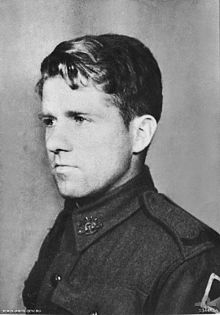Ted Kenna
| Edward "Ted" Kenna | |
|---|---|

Ted Kenna during his military service
|
|
| Born |
6 July 1919 Hamilton, Victoria |
| Died | 8 July 2009 (aged 90) Geelong, Victoria |
| Allegiance | Australia |
| Service/branch | Australian Army |
| Years of service | 1940–46 |
| Rank | Private |
| Unit | 2/4th Australian Infantry Battalion |
| Battles/wars |
Second World War |
| Awards | Victoria Cross |
Second World War
Edward "Ted" Kenna, VC (6 July 1919 – 8 July 2009) was the last living Australian Second World War recipient of the Victoria Cross, the highest decoration for gallantry "in the face of the enemy" that can be awarded to members of the British and Commonwealth armed forces.
Kenna served in the Citizens Military Force from August 1940 and was allotted service number V55955. In December 1941, the Citizens Military Force was called up for full-time service for the duration of the war. In June 1942, Kenna volunteered for the Second Australian Imperial Force and was allotted new service number VX102142. He served in the 23rd/21st Battalion in Victoria and later in the Darwin area. In June 1943, his unit returned to Victoria before being sent to Queensland. At this point, the unit was disbanded and its members allotted as reinforcements to other units. Kenna was assigned to the 2/4th Battalion and embarked for New Guinea in October 1944.
The citation for his VC was gazetted on 6 September 1945, and read:
War Office, 6th September, 1945.
The KING has been graciously pleased to approve the award of the VICTORIA CROSS to:-
No. VX.102142 Private Edward KENNA, 2/4 Australian Infantry Battalion, Australian Military Forces.
In the South West Pacific at Wewak on 15th May, 1945, during the attack on the Wirui Mission features, Private Kenna's company had the task of capturing certain enemy positions. The only position from which observation for supporting fire could be obtained was continuously swept by enemy heavy machine gun fire and it was not possible to bring Artillery or Mortars into action.
Private Kenna's platoon was ordered forward to deal with the enemy machine gun post, so that the company operation could proceed. His section moved as close as possible to the bunker in order to harass any enemy seen, so that the remainder of the platoon could attack from the flank. When the attacking sections came into view of the enemy they were immediately engaged at very close range by heavy automatic fire from a position not previously disclosed. Casualties were suffered and the attackers could not move further forward.
...
Wikipedia
